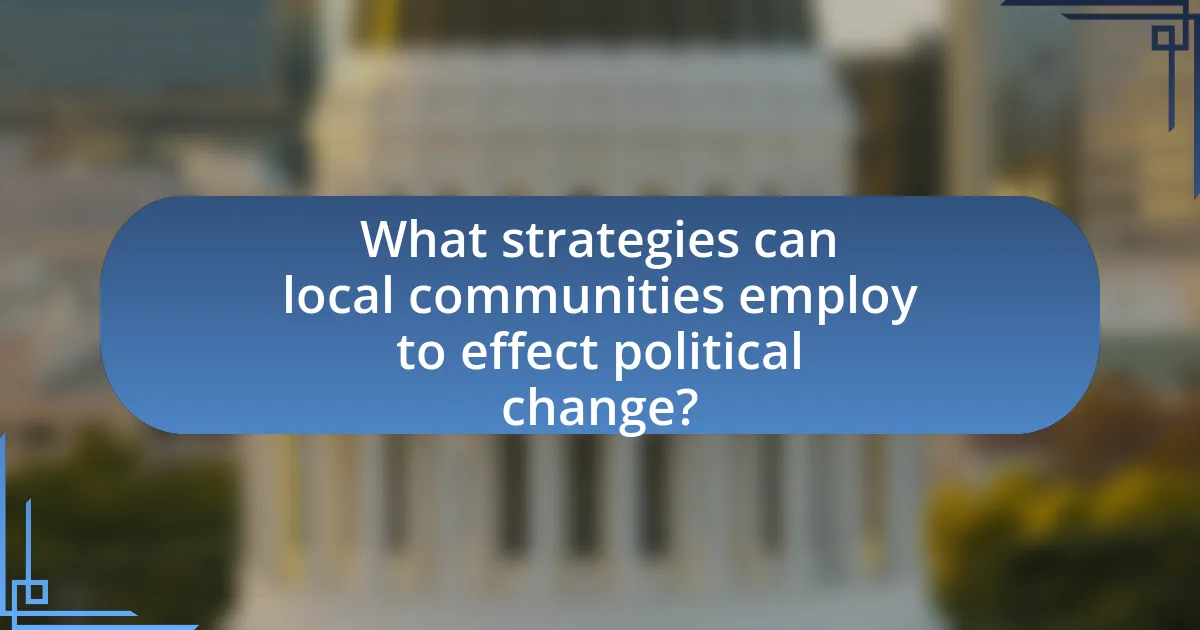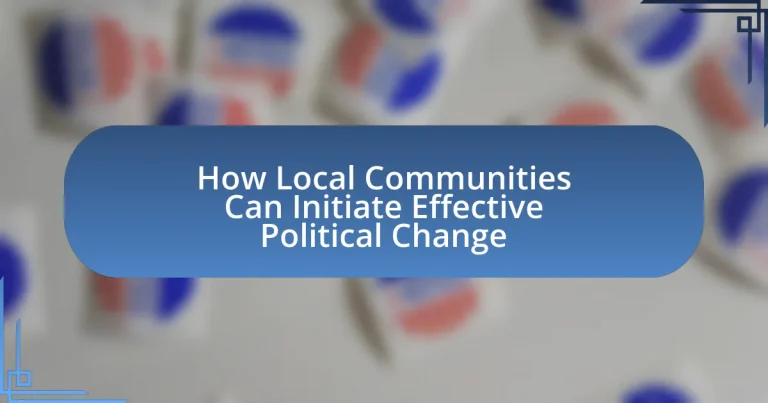Local communities are pivotal in initiating political change through grassroots movements and advocacy for local issues. This article explores how these communities identify political issues, assess their political landscape, and mobilize members for effective action. It highlights the importance of grassroots activism, coalition-building, and advocacy strategies, while also addressing challenges such as resource limitations and resistance from local authorities. Additionally, the article outlines practical steps for communities to create action plans and ensure sustained engagement, emphasizing best practices for successful political initiatives.

What is the role of local communities in initiating political change?
Local communities play a crucial role in initiating political change by mobilizing grassroots movements and advocating for local issues. These communities often serve as the foundation for collective action, where individuals unite to address shared concerns, influencing local governance and policy decisions. For instance, the Civil Rights Movement in the United States was significantly driven by local community organizations that organized protests and voter registration drives, leading to landmark legislation such as the Voting Rights Act of 1965. Additionally, studies show that community engagement in political processes increases voter turnout and civic participation, further demonstrating their impact on political change.
How do local communities identify political issues that need change?
Local communities identify political issues that need change through collective discussions, surveys, and community meetings. These methods facilitate the gathering of diverse perspectives, allowing residents to articulate their concerns and priorities. For instance, community forums often reveal common grievances such as inadequate public services or local governance issues, which can be quantified through surveys that assess the frequency and severity of these concerns. Research indicates that participatory approaches, such as town hall meetings, enhance civic engagement and help pinpoint specific political issues that require attention, thereby fostering a more informed and active citizenry.
What methods do communities use to assess their political landscape?
Communities assess their political landscape through methods such as surveys, public forums, and stakeholder interviews. Surveys gather quantitative data on public opinion regarding political issues, while public forums facilitate open discussions among community members, allowing for qualitative insights. Stakeholder interviews provide in-depth perspectives from key individuals involved in local governance, enhancing understanding of political dynamics. These methods collectively enable communities to identify priorities, gauge political engagement, and inform strategies for effective political change.
How can community engagement influence the identification of issues?
Community engagement significantly influences the identification of issues by fostering open communication between residents and local leaders, which helps to surface community-specific concerns. When community members actively participate in discussions, surveys, or forums, they provide valuable insights into their unique challenges and priorities, leading to a more accurate understanding of local issues. For instance, a study by the National Civic League found that communities with higher levels of engagement reported a 30% increase in the identification of pressing local issues compared to those with minimal engagement. This direct involvement not only highlights the most relevant problems but also empowers residents to take ownership of the solutions, thereby enhancing the overall effectiveness of political change initiatives.
Why is grassroots activism important for political change?
Grassroots activism is important for political change because it empowers local communities to influence decision-making processes directly. This form of activism mobilizes individuals at the community level, fostering collective action that can lead to significant political outcomes, such as policy reforms or shifts in public opinion. Historical examples, such as the Civil Rights Movement in the United States, demonstrate how grassroots efforts can challenge systemic injustices and lead to legislative changes, like the Voting Rights Act of 1965. Additionally, grassroots movements often reflect the needs and voices of marginalized populations, ensuring that diverse perspectives are represented in political discourse.
What are the key characteristics of grassroots movements?
Grassroots movements are characterized by their community-driven nature, emphasizing local participation and collective action. These movements typically arise from the needs and concerns of ordinary people rather than top-down directives from established institutions. They often focus on social justice, environmental issues, or political reform, mobilizing individuals to advocate for change through grassroots organizing, community engagement, and direct action.
Evidence of their effectiveness can be seen in movements like the Civil Rights Movement in the United States, which relied on local activists to challenge systemic racism and promote equality, demonstrating the power of grassroots efforts in achieving significant political and social change.
How do grassroots movements mobilize community members?
Grassroots movements mobilize community members by fostering a sense of shared identity and purpose, often through local organizing, outreach, and engagement strategies. These movements typically utilize community meetings, social media campaigns, and door-to-door canvassing to raise awareness about specific issues, encouraging participation and collaboration among residents. For example, the Black Lives Matter movement effectively mobilized community members through social media platforms, organizing protests and community discussions that highlighted systemic injustices, leading to increased local activism and policy discussions. This approach not only informs community members but also empowers them to take collective action, demonstrating the effectiveness of grassroots strategies in driving political change.

What strategies can local communities employ to effect political change?
Local communities can employ grassroots organizing, advocacy, and coalition-building to effect political change. Grassroots organizing involves mobilizing community members to participate in local governance, such as town hall meetings or community forums, which can influence decision-making processes. Advocacy efforts, such as lobbying local representatives or creating awareness campaigns, can highlight specific issues and push for legislative changes. Coalition-building with other organizations or community groups can amplify voices and resources, increasing the impact of political efforts. Historical examples, such as the Civil Rights Movement, demonstrate how local communities successfully utilized these strategies to achieve significant political reforms.
How can local communities build coalitions for political action?
Local communities can build coalitions for political action by identifying shared goals and interests among diverse groups. This process involves organizing meetings to discuss common issues, fostering relationships through networking, and creating a platform for collaboration. Research indicates that successful coalitions often emerge from grassroots movements where community members actively engage in dialogue and strategize collectively. For example, the formation of the Coalition for Immigrant Rights in Los Angeles in the early 2000s brought together various organizations to advocate for policy changes, demonstrating the effectiveness of unified efforts in political advocacy.
What are the benefits of forming coalitions with other organizations?
Forming coalitions with other organizations enhances collective impact and resource sharing. By collaborating, organizations can pool their expertise, funding, and networks, leading to more effective advocacy and broader reach. For instance, coalitions can amplify their voices on political issues, increasing visibility and influence in policy-making processes. Research indicates that collaborative efforts often result in more sustainable outcomes, as seen in the 2018 study by the National Council of Nonprofits, which found that organizations working together achieved 30% more in funding and support than those acting independently.
How can communities effectively communicate their goals within coalitions?
Communities can effectively communicate their goals within coalitions by establishing clear, concise messaging that aligns with the coalition’s objectives. This involves creating a shared vision statement that encapsulates the community’s goals and ensuring that all coalition members understand and can articulate this vision. Research indicates that coalitions with well-defined goals and consistent communication strategies are more successful in achieving their objectives, as evidenced by the Community Tool Box, which highlights the importance of clarity in messaging for coalition effectiveness. Additionally, regular meetings and collaborative platforms can facilitate ongoing dialogue, allowing communities to adapt their communication as needed and ensuring that all voices are heard.
What role does advocacy play in local political change?
Advocacy plays a crucial role in local political change by mobilizing community members to influence decision-makers and policies. Through organized efforts, advocacy groups raise awareness about specific issues, thereby shaping public opinion and encouraging civic engagement. For instance, the successful campaign for the establishment of community gardens in various cities demonstrates how advocacy can lead to policy changes that promote urban agriculture and sustainability. This illustrates that when communities advocate effectively, they can directly impact local governance and resource allocation, leading to tangible improvements in their neighborhoods.
How can communities develop effective advocacy campaigns?
Communities can develop effective advocacy campaigns by clearly defining their goals, identifying target audiences, and utilizing strategic communication methods. First, establishing specific, measurable objectives ensures that the campaign remains focused and impactful. For example, a community aiming to improve local healthcare access might set a goal to increase funding for clinics by a certain percentage within a year.
Next, understanding the demographics and interests of the target audience allows communities to tailor their messages effectively. Research shows that campaigns that resonate with the audience’s values and concerns are more likely to succeed.
Finally, employing various communication channels, such as social media, community meetings, and local media, enhances outreach and engagement. According to a study by the Pew Research Center, 69% of adults in the U.S. use social media, making it a vital tool for advocacy. By combining these elements, communities can create compelling advocacy campaigns that drive political change.
What tools and resources are available for community advocacy?
Community advocacy utilizes various tools and resources, including social media platforms, community organizing software, and educational materials. Social media platforms like Facebook and Twitter enable communities to mobilize support and disseminate information quickly, while community organizing software such as NationBuilder and Mobilize facilitate event planning and volunteer management. Educational materials, including guides and workshops, provide essential knowledge on advocacy strategies and local governance, empowering community members to engage effectively in political processes. These resources collectively enhance the capacity of communities to advocate for change and influence policy decisions.

What challenges do local communities face in initiating political change?
Local communities face several challenges in initiating political change, including lack of resources, limited access to political networks, and resistance from established political entities. These challenges hinder their ability to mobilize effectively and advocate for their interests. For instance, a study by the National Civic League highlights that communities often struggle with insufficient funding and organizational capacity, which are critical for sustaining advocacy efforts. Additionally, local communities may encounter bureaucratic obstacles and pushback from local governments or political leaders who may feel threatened by grassroots movements. This resistance can manifest in various forms, such as legal barriers or public opposition, further complicating the process of enacting change.
How can communities overcome resistance from local authorities?
Communities can overcome resistance from local authorities by building coalitions and engaging in strategic advocacy. By uniting various stakeholders, such as local organizations, businesses, and residents, communities can present a unified front that amplifies their voice and demonstrates widespread support for their initiatives. Research indicates that collective action can significantly influence local policy decisions, as seen in the case of the 2011 Occupy Wall Street movement, which galvanized public attention and prompted discussions on economic inequality. Additionally, communities should utilize data and evidence-based arguments to support their proposals, making it harder for local authorities to dismiss their concerns. For example, presenting statistics on community needs or successful case studies from similar regions can strengthen their position.
What strategies can be used to address opposition from political leaders?
To address opposition from political leaders, local communities can employ strategies such as building coalitions, engaging in dialogue, and leveraging public opinion. Building coalitions with like-minded organizations amplifies collective influence, as seen in the successful collaboration of environmental groups during the 2019 climate strikes, which pressured political leaders to take action. Engaging in dialogue allows communities to present their concerns and solutions directly to leaders, fostering understanding and potential compromise. Additionally, leveraging public opinion through campaigns and social media can sway political leaders by demonstrating widespread support for specific issues, as evidenced by the impact of grassroots movements like Black Lives Matter, which significantly influenced political discourse and policy changes.
How can communities build public support to counteract resistance?
Communities can build public support to counteract resistance by actively engaging stakeholders through transparent communication and inclusive decision-making processes. This approach fosters trust and encourages participation, as evidenced by the success of community-led initiatives like the “Participatory Budgeting” model, which has been implemented in cities such as New York and Paris, resulting in increased civic engagement and support for local projects. By demonstrating the tangible benefits of proposed changes and addressing concerns through dialogue, communities can effectively mobilize public opinion in their favor.
What are the common pitfalls in community-led political initiatives?
Common pitfalls in community-led political initiatives include lack of clear goals, insufficient community engagement, and inadequate resources. These issues often lead to disorganization and failure to achieve desired outcomes. For instance, a study by the National Civic League found that initiatives lacking specific objectives often struggle to maintain momentum and support. Additionally, when community members are not actively involved in the planning and decision-making processes, initiatives can become disconnected from the needs and desires of the community, resulting in low participation rates. Furthermore, limited financial and human resources can hinder the implementation of initiatives, as evidenced by research from the Urban Institute, which highlights that resource constraints are a significant barrier to effective community organizing.
How can communities avoid burnout among activists?
Communities can avoid burnout among activists by implementing structured support systems that promote well-being and sustainable engagement. These systems can include regular check-ins, mental health resources, and opportunities for rest and recovery, which help maintain activists’ motivation and energy levels. Research indicates that organizations with supportive environments experience lower turnover rates and higher satisfaction among members, demonstrating the effectiveness of such measures in preventing burnout.
What steps can be taken to ensure sustained engagement over time?
To ensure sustained engagement over time, local communities should implement regular communication, establish clear goals, and foster inclusive participation. Regular communication keeps community members informed and connected, which is essential for maintaining interest and involvement. Establishing clear goals provides a shared vision that motivates individuals to stay engaged, as they can see the impact of their contributions. Fostering inclusive participation ensures that diverse voices are heard, which enhances community ownership and commitment to the cause. Research indicates that communities with structured engagement strategies experience higher levels of participation and satisfaction, leading to more effective political change initiatives.
What practical steps can local communities take to initiate effective political change?
Local communities can initiate effective political change by organizing grassroots movements that focus on specific issues, engaging in local governance, and fostering civic education. Grassroots movements empower residents to advocate for policy changes by mobilizing support and raising awareness about local concerns, as seen in successful campaigns like the Civil Rights Movement, which utilized community organizing to effect legislative change. Engaging in local governance involves attending town hall meetings, participating in public forums, and collaborating with local officials to influence decision-making processes. Additionally, fostering civic education equips community members with the knowledge and skills necessary to understand political systems and advocate for their interests, as demonstrated by initiatives like the League of Women Voters, which promotes informed and active participation in government. These steps collectively enhance community influence and drive political change.
How can communities create a clear action plan for political initiatives?
Communities can create a clear action plan for political initiatives by first identifying specific goals and objectives that address local issues. This involves gathering input from community members through surveys, town hall meetings, or focus groups to ensure diverse perspectives are included. Once goals are established, communities should outline actionable steps, assign responsibilities, and set timelines for each task.
For example, the National Civic League emphasizes the importance of collaboration and engagement in the planning process, which can lead to more effective initiatives. Additionally, utilizing resources such as the Community Tool Box provides frameworks and strategies for developing action plans, ensuring that communities have access to proven methodologies. By following these structured approaches, communities can enhance their chances of successfully implementing political initiatives.
What best practices should communities follow to ensure successful outcomes?
Communities should engage in inclusive participation to ensure successful outcomes. This involves actively involving diverse stakeholders in decision-making processes, which fosters a sense of ownership and accountability. Research shows that inclusive participation leads to better policy outcomes, as seen in the 2018 study by the National Civic League, which found that communities with higher engagement levels experienced a 30% increase in successful project implementations. Additionally, establishing clear communication channels enhances transparency and trust, further contributing to effective political change.


